MAY
1940
Europe
10th
- Germany invaded Holland, Belgium,
Luxembourg
Norwegian
Campaign - The
Allies had evacuated central
Norway, but continued to build up forces for the
attack
on Narvik in the north. By the 23rd
carriers “Furious”
and “Glorious”
had flown ashore the first modern RAF fighters.
JUNE
1940
Europe
Norwegian
Campaign - At the
end of the evacuation, fleet
carrier
“GLORIOUS” (below) and escorting
destroyers “ACASTA” and “ARDENT” sailed for
Britain independently
of the other withdrawing forces. West of Lofoten
Islands
on the 8th they met the 11in gun battlecruisers
“Scharnhorst” and “Gneisenau” sailing
to attack suspected Allied shipping off Harstad.
The
British ships were soon overwhelmed and sunk,
but not
before “Acasta” hit “Scharnhorst” with a
torpedo. Few of the Royal
Navy crews survived.
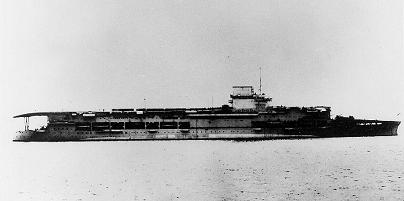
13th
- Five days
after the sinking of “Glorious”, aircraft
from carrier
“Ark Royal”
attacked the damaged “Scharnhorst” in Trondheim
but to little effect.
Mediterranean
10th
- Italy Declared War on Britain and
France
|
Mediterranean
Naval
Strengths - The Western
Mediterranean was
primarily the responsibility of the
French Navy - although British
reinforcements could soon be
dispatched from the
Home Fleet as shortly happened. The
Eastern
Mediterranean was in the hands of the
Mediterranean Fleet and a small French
squadron
based at Alexandria. It was up
to strength
in major units but still weak in
cruisers,
destroyers and submarines when
compared with the
Italian Navy. This was partly offset
by the
presence
of carrier “Eagle”
to accompany
battleships “Malaya”,
“Ramillies”, “Royal
Sovereign” and “Warspite”. The
large Italian fleet was mainly based
in the
Mediterranean, but had
no
carriers. |
12th -The
Mediterranean Fleet with “Warspite”, “Malaya”,
carrier
“Eagle”,
cruisers and destroyers sailed from Alexandria
for a
sweep against Italian shipping in the Eastern
Mediterranean. South of Crete, light cruiser
“CALYPSO”
was
torpedoed and
sunk by Italian
submarine “Bagnolini”.
British Force H -
By the end of the month, Force H had been
assembled at
Gibraltar from units of the Home Fleet. Vice-Adm
Sir
James Somerville flew his flag in battlecruiser
“Hood” and commanded battleships
“Resolution” and “Valiant”,
carrier
“Ark Royal”
and a few cruisers and destroyers. From
Gibraltar, Force
H could cover the Western Mediterranean and the
Atlantic.
JULY
1940
Atlantic
French
Navy in the Atlantic - Carrier
“Hermes” and
cruisers “Dorsetshire” and Australian
sister-ship “Australia” laid off Dakar,
French West Africa on the 8th after negotiations
were
refused on the future of French battleship
“Richelieu”. Attacks made with depth-charges
from a fast motorboat failed and a torpedo
strike by
Swordfish inflicted only minor damage.
Mediterranean
French
Navy
in the Mediterranean - In the
Action at Oran
(Operation
'Catapult'), Adm Somerville arrived with
Force H off
the French Algerian base of Mers-el-Kebir near
Oran on
the 3rd. French Adm Gensoul was offered a number
of
choices to ensure his fleet with its four
capital ships
stayed out of Axis hands. All were turned down
and, at
around 18.00, Force H opened fire on the
anchored ships. "BRETAGNE"
blew up and the "Dunkerque"
and "Provence", together with other ships, were
badly damaged. Battlecruiser "Strasbourg" and
some destroyers managed to break out in spite of
attacks
by aircraft from
carrier
"Ark
Royal", and reached Toulon in the south of
France.
Three days later the damaged "Dunkerque"
was torpedoed
at her moorings by
"Ark
Royal's" Swordfish. The
tragic and unhappy episode was over as far as
Oran was
concerned.
5th -
Obsolescent
torpedo-carrying Swordfish from
carrier "Eagle's" squadrons
flew from land bases on
successful attacks against Tobruk and area. On
the 5th,
aircraft of 813 Squadron sank Italian destroyer
"ZEFFIRO" and a freighter at Tobruk. The
success was repeated two weeks later
9th
- Action off Calabria or Battle of
Punto Stila - On
the 7th, Adm Cunningham sailed from
Alexandria
with battleships "Warspite", Malaya",
Royal Sovereign",
carrier "Eagle",
cruisers and destroyers
to cover convoys from Malta to Alexandria and to
challenge the Italians to action. Next day - the
8th
- two Italian battleships, 14 cruisers and 32
destroyers
were reported in the Ionian Sea covering a
convoy of
their own to Benghazi in Libya. Italian aircraft
now
started five days of accurate high-level bombing
(also
against Force H out of Gibraltar) and cruiser
"Gloucester"
was
hit and
damaged. Mediterranean
Fleet headed for a position to cut off the
Italians from
their base at Taranto. On the 9th,
"Eagle's"
aircraft failed to find
the Italians and first contact was made by a
detached
cruiser squadron which was soon under fire from
the
heavier Italian ships. "Warspite" came up and
damaged
"Giulio Cesare" with a 15in hit. As the Italian
battleships
turned away, the British cruisers and destroyers
engaged,
but with little effect. Mediterranean Fleet
pursued to
within 50 miles of the south west Italian coast
off
Calabria before withdrawing. As Adm Cunningham
covered
the by now delayed convoys to Alexandria,
"Eagle's" Swordfish attacked Augusta harbour,
Sicily on the 10th. Destroyer
"Pancaldo"
was torpedoed,
but later re-floated and
re-commissioned.
20th -
"Eagle's" Swordfish
continued their strikes against Italian targets
around
Tobruk. In the nearby Gulf of Bomba, 824
Squadron was
responsible for sinking destroyers "NEMBO" and
"OSTRO" and another freighter.
STRATEGIC &
MARITIME
SITUATION - MEDITERRANEAN
With the fall of
France, Italy
continued to dominate the central
Mediterranean. The
comparatively healthy naval position also
changed
for the worse. In all except capital ships –
seven
British to six Italian - the Royal Navy was
distinctly
inferior in numbers to the Italians, but had its
two
near-priceless fleet carriers – “Ark Royal”
based on
Gibraltar, and “Eagle”, later joined by
“Illustrious” operating out of Alexandria. They
would dominate the Mediterranean over the next
six
months.
AUGUST
1940
Atlantic
Battle
of
the Atlantic - Long
range
Focke Wulf Kondor bombers started patrols off
the
coast of Ireland. As well as spotting for
U-boats they
attacked and sank many ships, and continued to
be a major
threat until the introduction of ship-borne
aircraft in late 1941 started to counteract
them.
Mediterranean
Malta - The
decision was taken to reinforce Malta and in
Operation 'Hurry',
carrier
"Argus" flew off 12 Hurricanes from a position
southwest of Sardinia. This was the first of
many
reinforcement and supply operations, often
bitterly
fought to keep Malta alive and in the fight
against Axis
supply routes to their armies in North Africa.
Now, as in
the future, cover from the west was provided by
Force H.
The opportunity was taken for carrier "Ark
Royal's" aircraft to hit
Sardinian targets.
22nd -
Land-based
Swordfish from
carrier "Eagle's"
824 Squadron repeated their July
success with another torpedo strike in the Gulf
of Bomba
near Tobruk. Just as she prepared for a human
torpedo
attack on Alexandria, submarine "IRIDE" and a
depot ship were sunk.
SEPTEMBER
1940
Atlantic
23rd-25th
- Dakar Expedition, Operation
'Menace' - Because
of Dakar's strategic importance to the North and
South
Atlantic shipping routes, an expedition was
mounted to
acquire the port for Allied use. Free French
troops led
by Gen de Gaulle were carried in ships escorted
and
supported by units of the Home Fleet and Force H
under
the command of Vice-Adm John Cunningham. They
included
battleships "Barham" and "Resolution",
carrier
"Ark
Royal", three heavy cruisers. Naval forces at
Dakar
included the unfinished battleship "Richelieu"
and two cruisers recently arrived from Toulon.
Attempts
to negotiate on the 23rd soon failed and
as Vichy
French ships tried to leave harbour, shore
batteries
opened fire, damaging heavy cruiser "Cumberland"
and two destroyers. Shortly
afterwards, the Vichy submarine "PERSEE" was
sunk by gunfire and large destroyer
"L'AUDACIEUX" disabled by cruiser
"Australia" and beached. A Free French landing
was beaten off. Next day, on the 24th,
Dakar was
bombarded by the warships and "Richelieu"
attacked by carrier
"Ark Royal's"
aircraft. Vichy submarine
"AJAX" was sunk by destroyer
"Fortune". The bombardment continued on the 25th,
but battleship "Resolution"
was now
torpedoed and badly damaged by
submarine "Beveziers" and "Barham"
hit by "Richelieu's" 15in gunfire. At this
point the operation was abandoned and the
Anglo-Free
French forces withdrew.
Mediterranean
Royal Navy in the
Mediterranean - Reinforcements were sent
to the
Mediterranean Fleet in Alexandria right through
until the
end of the year. They were covered from
Gibraltar by Adm
Somerville's Force H, then met in the central
basin by
Adm Cunningham and escorted the rest of the way.
The
opportunity was usually taken to carry in
supplies of men
and material to Malta. Early in September new
fleet
carrier
"Illustrious" with its armoured flight deck,
battleship "Valiant" and two cruisers were
transferred in this way in Operation 'Hats'. On
passage
with the new arrivals, aircraft from Force H's
"Ark
Royal" attacked Sardinian targets. After joining
up
with carrier "Eagle"
and
now in the eastern Med, "Illustrious" sent
aircraft against Rhodes. The Italian Fleet
sortied during
these operations, but failed to make contact.
The arrival
of "Illustrious" allowed Adm Cunningham to go
ahead with his plans to attack the Italian
battlefleet at
Taranto.
17th - Units
of the
Mediterranean Fleet including battleship
"Valiant" sailed with
carrier "Illustrious"
for a raid on
Benghazi. Swordfish biplanes torpedoed destroyer
"BOREA", and mines laid by them off the
port sank "AQUILONE".
OCTOBER
1940
Mediterranean
12th/14th
-
Attacks on Malta Convoy - From
Alexandria a convoy safely reached Malta
covered by the Mediterranean Fleet with four
battleships
and
carriers "Illustrious"
and
"Eagle". As the Fleet returned on the
12th, attacks were made by Italian light
forces
southeast of Sicily. Cruiser "Ajax" sank
Italian torpedo boats "AIRONE" and "ARIEL" and
badly damaged destroyer "ARTIGLIERE" which was
finished off by heavy
cruiser "York". Later heading back east, the
carriers
launched air strikes
against Leros
island in the Dodecanese.
NOVEMBER
1940
Mediterranean
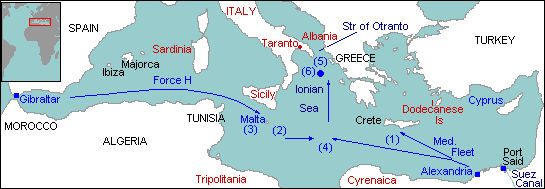
11th
- Fleet Air Arm Attack on Taranto,
Operation 'Judgement' - Early
in the month a complex series of
reinforcement and supply moves
(1-5)
mounted from both ends of the
Mediterranean led to the classic air attack
(6) on
the Italian battlefleet at
Taranto. (1)
From Alexandria, Adm Cunningham,
with battleships "Malaya",
"Ramillies", Valiant" and
"Warspite", carrier "Illustrious",
cruisers and destroyers, sailed to cover
west-bound
convoys to Crete and Malta. Aircraft carrier
"Eagle" had to be left behind because of
defects caused by earlier bombing.
(2)
From Gibraltar, Force H in a
separate operation called "Coat" supported the
east-bound passage of battleship "Barham", two
cruisers and three destroyers to reinforce the
Mediterranean Fleet.
(3)
Troop reinforcements were also carried to
Malta at this time from Gibraltar.
(4)
Still in the eastern half of the
Med, Adm Cunningham's Fleet met its new members
and
covered the return of an empty ship convoy from
Malta. (5)
On the 11th a cruiser force
was detached for a successful attack on Italian
shipping
in the Strait of Otranto at the entrance to the
Adriatic
Sea. (6)
"Illustrious" meanwhile,
escorted by cruisers and destroyers, headed for
a
position in the Ionian Sea 170 miles to the
southeast of
Taranto. All six battleships of the Italian Navy
were at
anchor there. That night she launched two waves
of
Swordfish biplanes, some belonging to "Eagle".
Under the command of Lt-Cdrs K. Williamson and
J. W.
Hale, the total of no more than 20 aircraft of
Number
813, 815, 819 and 824 Squadrons hit "CONTE DI
CAVOUR" and "CAIO
DIULIO" with one
torpedo each and the brand new "LITTORIA" with
three. All three
battleships sank at their moorings and "Cavour"
was never recommissioned, all for the loss of
just two Swordfish.
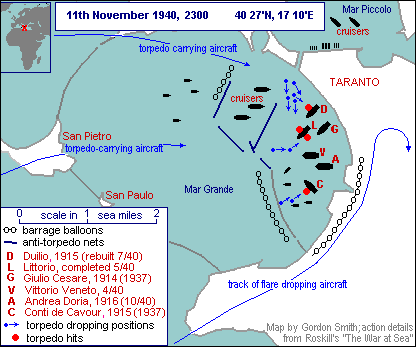
The
Japanese
Navy carefully studied the attack as Pearl
Harbor learnt
to its cost just a year later.
27th
- Action off Cape Spartivento,
Southern Sardinia - A fast
convoy under the codename Operation
'Collar' sailed eastward from Gibraltar with
ships for
Malta and Alexandria. Cover as usual was
provided by
Force H with battlecruiser "Renown",
carrier
"Ark Royal", cruisers
"Despatch" and
"Sheffield" Meanwhile, units of the
Mediterranean Fleet including "Ramillies" and
cruisers "Newcastle", "Berwick" and
"Coventry" headed west for a position south of
Sardinia to meet them. Other ships accompanied
the two
Mediterranean Fleet
carriers in separate
attacks on Italian targets -
"Eagle" on Tripoli, Libya and
"Illustrious" on Rhodes off the southwest
Turkish coast. These moves took place on the 26th.
Next day, on the 27th, south of
Sardinia, aircraft
of Force
H carrier "Ark
Royal"
sighted an Italian force with two battleships
and seven heavy cruisers. Force H, now joined by
the Med
Fleet's "Ramillies", sailed to meet them. In an
hour-long exchange of gunfire "Renown" and the
cruisers were in action, during which time
"Berwick"
was
damaged and an Italian destroyer
badly hit. The slower "Ramillies" had not come
up by the time the Italians had turned back for
home. Adm
Somerville pursued, but as he approached Italian
shores
had to turn back himself. The convoys arrive
safely.
DECEMBER
1940
Mediterranean
Mediterranean
Operations - Another series of convoy and
offensive
operations were carried out by the Mediterranean
Fleet
with battleships "Warspite", "Valiant
"and carrier
"Illustrious".
On the 17th
carrier aircraft attacked Rhodes and on the
night of the 18th/19th
the two battleships bombarded Valona, Albania.
At the
same time, battleship "Malaya" passed through
to the west for Gibraltar. On the way, escorting
destroyer "HYPERION" hit a nine near Cape Bon,
northeast tip of
Tunisia on the 22nd and had to be
scuttled.
"Malaya" carried on to meet up with Force H.
The German
Luftwaffe's X
Fliegerkorps - including Ju87 Stuka dive-bombers
- was
ordered to Sicily and southern Italy to bolster
the
Italian Air Force.
|
Mediterranean
Theatre
after Seven Months - Mussolini's
claimed
domination of the Mediterranean had
not been
apparent. In spite of the loss of
French naval
power, Force H and the Mediterranean
Fleet and
their carriers had more than held
the Italian Navy
in check. Malta had been supplied
and reinforced,
and the British offensive in North
Africa was
underway. Elsewhere, the Greeks were
driving the
Italians back into Albania and away
to the south
the Italian East African Empire was
about to be
wound up.
However,
it was
now only a matter of months and even
weeks before
the Luftwaffe appeared in Sicily,
Gen Rommel in North Africa and the
German Army in Greece, followed by
their
Paratroops in Crete
|
1941
JANUARY
1941
Mediterranean
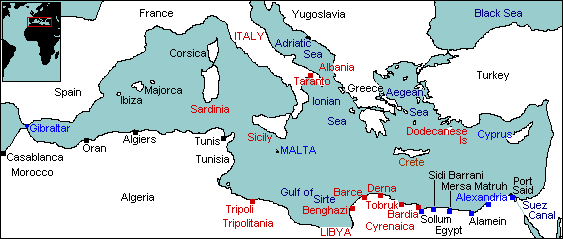
6th-11th
- Malta Convoy
"Excess" - Another
complex series of convoy and ship
movements (1-6)
revolving around Malta led
to carrier "Illustrious"
being badly
damaged
and the Royal Navy losing its comparative
freedom of
operation in the Eastern Mediterranean. This
followed the
arrival in Sicily of the German Luftwaffe's X
Fliegerkorps. (1) On
the
6th, convoy 'Excess' left Gibraltar for Malta
and
Greece covered by Gibraltar-based Force H. (2)
At the same time the Mediterranean
Fleet from Alexandria prepared to cover supply
ships to
Malta and (3) bring
out empty ones. (4)
Mediterranean Fleet cruisers
"Gloucester" and "Southampton"
carried troop reinforcements to Malta and then (5)
continued on west to meet
'Excess'. (6)
Force
H returned to Gibraltar.
By the 10th,
'Excess' had reached the Strait of Sicily and
was
attacked by Italian torpedo boats. "VEGA"
was
sunk by escorting
cruiser
"Bonaventure" and destroyer
"Hereward". As the Mediterranean Fleet
including "Illustrious" met the convoy off the
Italian-held island of Pantelleria, screening
destroyers "GALLANT" hit a mine. Still west of
Malta,
heavy attacks by German and Italian aircraft
were launched.
Carrier
"Illustrious"
was
singled out
and hit six times by
Ju87 and Ju88 bombers. Only the armoured flight
deck
saved her from total destruction as she
struggled into
Malta with 200 casualties. There, under
continual attack,
she was repaired temporarily and left on the
23rd for
Alexandria.
Sister-ship
"Formidable"
was sent out to replace her via the Cape of Good
Hope,
but it was some weeks before she reached the
Eastern
Mediterranean. All merchantmen reached their
destinations
safely, but at a cost of a cruiser and
destroyer, and the
loss
of
carrier "Illustrious'"
vital air power.
FEBRUARY
1941
Mediterranean
9th
- Force H Attack in the Gulf of Genoa
- "Renown",
"Malaya" and
carrier "Ark Royal,"
sailed right up into the Gulf of Genoa,
northwest Italy.
The big ships bombarded the city of Genoa while
"Ark
Royal's" aircraft bombed Leghorn and laid mines
off
Spezia, all on the 9th. An Italian battlefleet
sortied
but failed to
make
contact.
MARCH
1941
Atlantic
Battle
of
the Atlantic - On 6th March 1941, faced
with the
mortal threat of the German U-boat and aircraft
offensive
in the Atlantic, Winston Churchill
issued his famous Battle of the
Atlantic directive. Catapult armed merchantmen
(CAM) were to be fitted out,
merchant ships equipped with AA weapons as a
first
priority, and more Coastal Command squadrons
formed and
fitted with radar. Port and dockyard congestion
was to be
dealt with and the defence of ports greatly
improved.
Mediterranean
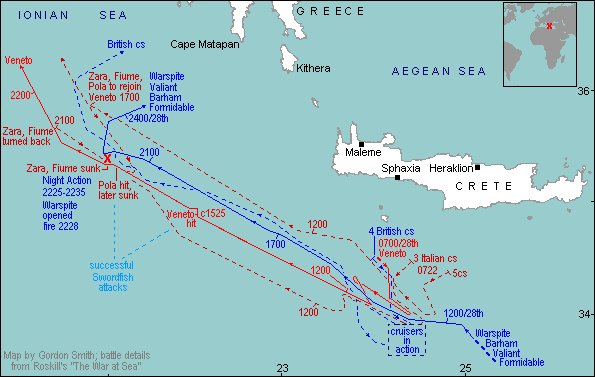
28th
- Battle of Cape Matapan - As
ships of the Mediterranean Fleet
covered troop movements to Greece, 'Ultra'
intelligence
was received reporting the sailing of an Italian
battlefleet with one battleship, six heavy and
two light
cruisers plus destroyers to attack the convoy
routes. On
the 27th, Vice-Adm Pridham-Wippell with
cruisers
"Ajax", "Gloucester",
"Orion" and the Australian "Perth"
and destroyers sailed from Greek waters for a
position
south of
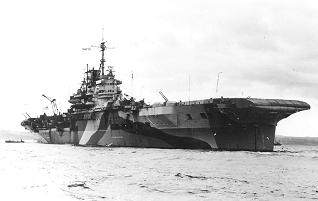 Crete.
Adm Cunningham with
carrier "Formidable"
(right) and battleships
"Warspite", "Barham" and
"Valiant" left Alexandria on the same day to
meet the cruisers. Around 08.30 on the 28th,
south
of Crete, Adm Pridham- Wippell was in action
with an
Italian cruiser squadron. Just before noon he
found
himself between them and the battleship
"Vittorio
Veneto" which had now come up. An attack by
Swordfish from
carrier "Formidable" failed to
hit the Italian battleship, but enabled the
British
cruisers to extricate themselves. Mediterranean
Fleet
heavy units arrived, but their only chance of
action was
to slow down the Italians before they could
reach Italy.
A second Swordfish carrier aircraft
strike at around 15.25 hit and slowed
down "Vittorio
Veneto", but only
for a short while. At 19.30 a third
carrier
strike southwest of Cape Matapan
stopped heavy cruiser "Pola".
Crete.
Adm Cunningham with
carrier "Formidable"
(right) and battleships
"Warspite", "Barham" and
"Valiant" left Alexandria on the same day to
meet the cruisers. Around 08.30 on the 28th,
south
of Crete, Adm Pridham- Wippell was in action
with an
Italian cruiser squadron. Just before noon he
found
himself between them and the battleship
"Vittorio
Veneto" which had now come up. An attack by
Swordfish from
carrier "Formidable" failed to
hit the Italian battleship, but enabled the
British
cruisers to extricate themselves. Mediterranean
Fleet
heavy units arrived, but their only chance of
action was
to slow down the Italians before they could
reach Italy.
A second Swordfish carrier aircraft
strike at around 15.25 hit and slowed
down "Vittorio
Veneto", but only
for a short while. At 19.30 a third
carrier
strike southwest of Cape Matapan
stopped heavy cruiser "Pola".
Later that evening
(still
on the 28th), two more heavy cruisers - "Fiume"
and "Zara with four destroyers were detached to
help
"Pola". Before reaching her, Adm Cunningham's
ships detected them by radar and "FIUME",
"ZARA" and
destroyers "ALFIERI" and "CARDUCCI" were
crippled by the close range gunfire
of "Barham", "Valiant" and
"Warspite". All four Italians were finished off
by four destroyers led by the Australian
"Stuart". Early next morning on the 29th,
"POLA" was
found, partly
abandoned. After taking off the remaining crew,
destroyers "Jervis" and "Nubian" sank
her with torpedoes. The Royal Navy lost one
aircraft.
APRIL
1941
Atlantic
Battle
of
the Atlantic - Over the
next few months a number of long awaited
ship types and weapons started to be introduced.
These
would contribute significantly to the eventual
defeat of
the U-boat and includd: (1) The first Auxiliary
Fighter
Catapult Ships flying
the White Ensign and equipped with a
single
'one-way' Hurricane were ready in April 1941.
They shot
down their first Kondor in August. In May a
Hurricane was
successfully launched from a Red Ensign
Catapult Armed
Merchantman (CAM), but
they did not claim their first victim until
November.
CAM-ships were eventually superseded in 1943 by
Merchant Aircraft
Carriers (MACs) -
merchantmen with full flightdecks, but sailing
under the
Red Ensign and also carrying oil or grain. (2)
The final
step in the introduction of ship-borne aircraft
into the
Battle of the Atlantic came in June when the
first escort carrier
was ready
for service. HMS Audacity,
converted from a German prize, had a short life,
but
proved the great value of these vessels.
Mediterranean
3rd - Leading
up to
the capture of Massawa, capital of the Italian
colony of
Eritrea, the surviving eight Italian destroyers
and
torpedo boats were lost or scuttled. On the 3rd,
five
seaworthy destroyers sailed to attack Port
Sudan, Sudan
further north along the Red Sea shore.
Shore-based
Swordfish from
carrier
"Eagle" sank
"MANIN" and "SAURO".
Malta - In
the
first week of April,
carrier
"Ark Royal"
escorted by Force H
sailed from Gibraltar and flew off 12
Hurricanes
for Malta. Three weeks later the operation was
repeated
with 20 more aircraft. From the other end of the
Mediterranean, Alexandria-based
battleships
"Barham", "Valiant" and
"Warspite" together
with
carrier
"Formidable" covered
the
movement of fast transport "Breconshire" to
Malta. On the 21st they bombarded Tripoli on the
return.
MAY
1941
Atlantic
18th-28th
- Hunt for the
"Bismarck" - Starting
on the 18th, new German 15in battleship
"Bismarck" and heavy cruiser "Prinz
Eugen" sailed from Gdynia in the Baltic for the
Atlantic via Norway. A simultaneous sortie by
the
battlecruisers "Scharnhorst" and
"Gneisenau" from Brest was fortunately
prevented by the damage inflicted by the RAF. 21st
- In the evening the German ships were sighted
in a fiord
south of Bergen, Norway. Two of the Home Fleet's
capital
ships, "Hood" and "Prince of Wales"
(still not fully completed and working up),
sailed from
Scapa Flow towards Iceland to support the
cruisers on
Northern Patrol. 22nd - "Bismarck" was
reported at sea and the main body of the Home
Fleet
under Adm Tovey left Scapa Flow and headed west.
Battleship "King George V", fleet
carrier
"Victorious",
cruisers and destroyers were later joined by
battlecruiser "Repulse". "Victorious"
was also a recent addition to the Fleet and also
working
up. 23rd - In the early evening, heavy
cruisers
"Suffolk" and shortly "Norfolk"
sighted the German ships north west of Iceland
and
shadowed them southwestwards through the Denmark
Strait
separating Iceland from Greenland to the west.
"Hood" and "Prince of Wales" pressed
on to intercept west of Iceland. 24th -
That
morning the big ships met and opened fire.
Around 06.00,
after firing two or three salvos, "Bismarck"
hit "HOOD" which blew up with only three
survivors. Now it was "Prince of Wales" turn to
be the target. After being
hit several times she turned away but not before
damaging
"Bismarck" and causing her to lose fuel oil
to the sea. German Adm Lutjens decided to make
for St
Nazaire in France and headed southwest and later
south
out of the Denmark Strait. The two Royal Navy
cruisers,
and for a while the damaged "Prince of Wales",
continued to shadow. Adm Tovey hurried west with
the rest
of Home Fleet. With "Hood's" loss, Force H (Adm
Somerville)
with battlecruiser "Renown",
carrier
"Ark Royal"
and cruiser "Sheffield" was sailing north from
Gibraltar. Battleship "Ramillies", released
from convoy escort duties, and "Rodney", then
to the west of Ireland, headed towards
"Bismarck's" expected track.
"Ramillies" played no part in later operations.
At 18.00,
still an
the 24th, "Bismarck" feinted north towards her
shadowers for long enough to allow "Prinz
Eugen" to get away. Around midnight,
southeast of Cape Farewell, Swordfish from Adm
Tovey's
carrier
"Victorious"
got one hit on "Bismarck" after she had resumed
her southerly course. The damage was negligible.
Shortly
after, in the early hours of the 25th,
she altered
course to the southeast for France and the
cruisers lost
contact. At this point Adm Tovey's heavy ships
were only
100 miles away. 25th - "Bismarck" held
her southeasterly course, but broke
radio silence.
Unfortunately the British direction-finding
service put
her on a northeasterly heading. Adm
Tovey sailed
in that direction for a while before turning to
the
southeast in pursuit. Now he was well astern of
his
quarry. Only by slowing her down could
destruction become
possible. In the meantime, Force H continued to
sail
north to take up a blocking position between
"Bismarck" and her new goal of Brest.
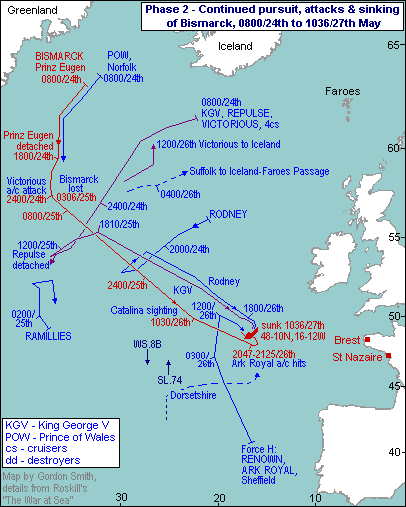
26th - After
a
30-hour interval, "Bismarck" was once more
sighted, this time by a RAF Catalina of No 209
Squadron,
and only 30hr from home. In the afternoon a
Swordfish
strike from Force H's
carrier
"Ark Royal"
attacked
cruiser
"Sheffield" in error. They missed. A second
strike took place in the evening by 810,
818 and
820 Squadrons with 15 Swordfish led by Lt-Cdr
Coode. They
torpedoed "Bismarck" twice and one hit damaged
her propellers and jammed the rudder. As
"Bismarck" circled, destroyers of the 4th
Flotilla (Capt Vian) came up around midnight,
and
made a series of torpedo and gun attacks but
with
uncertain results. Capt Vian's "Cossack",
"Maori", "Sikh", "Zulu" and
Polish "Piorun" had been detached from troop
convoy ("Winston's Special") WS8B, an
indication of the seriousness of the "Bismarck"
threat. By this time Adm Tovey's force of heavy
ships had
lost "Repulse" to refuel, but been joined by
"Rodney". They now came up from the west but
did not attack just yet. 27th - "King
George
V", "Rodney" and the still circling
"Bismarck" all opened fire around 08.45.
Only the German ship was hit and by 10.15
she was
a blazing wreck. Heavy cruiser "Dorsetshire",
having left convoy SL74 the previous day, fired
torpedoes
to finish her off. "BISMARCK" sank at 10.36
to the southwest of
Ireland. Shadowing cruiser "Norfolk" was there
at the end..
Mediterranean
Royal Navy
Operations
in the Mediterranean - Early in the
month, Force H
and the Mediterranean Fleet carried out another
series of
complicated supply, reinforcement and offensive
operations. (1) Five fast transports
sailed from Gibraltar
with tanks and supplies urgently needed for the
Army of
the Nile (Operation 'Tiger'). Four arrived
safely. (2) On passage they were
accompanied
by battleship "Oueen Elizabeth" and two
cruisers sailing to join the Mediterranean
Fleet. (3) Two small convoys were
escorted
westward from Egypt to Malta. (4)
Other units of the Mediterranean
Fleet shelled Benghazi, Libya on the night of
the
7th/8th. (5) After covering the 'Tiger'
convoy,
carrier "Ark
Royal" joined by carrier "Furious", was
once again south of Sardinia and flying off a
further 48
Hurricanes to Malta
on
the 21st. Five days later, "Ark Royal's"
Swordfish were crippling the "Bismarck" in the
North Atlantic!
21st
May-1st June - Battle for Crete - Most
of the Mediterranean Fleet with
four battleships, one carrier, 10 cruisers and
30
destroyers fought the Battle. For the Navy there
were two
phases, both of which took place under intense
air
attack, mainly German, from which all losses
resulted. Phase
One was from the German airborne invasion
on the 20th
until the decision was take on the 27th to
evacuate the
island. During this time the Mediterranean Fleet
managed
to prevent the sea-borne reinforcement of the
German
paratroops fighting on Crete, but at heavy cost.
Most of
these losses happened as the ships tried to
withdraw from
night-time patrols north of the island out of
range of
enemy aircraft. On the 26th, carrier
"Formidable", accompanied by battleships
"Barham" and "Queen Elizabeth", flew
off aircraft from a position well to the south
for an
attack on the Scarpanto Island airfields. In the
counter-attack "Formidable" and destroyer
"Nubian" were
damaged. Phase
Two was from
27th May to 1st June when over 15,000 British
and
Dominion troops were evacuated. Ten thousand had
to be
left behind and again the naval losses were
heavy.
Throughout the two phases, losses included three
cruisers
and six destroyers sunk, two battleships, one
carrier and
five cruisers badly damaged.
JUNE
1941
Germany
invaded Russia
Mediterranean
Malta - With
German
forces now in Greece and Crete the problems of
supplying
Malta were even greater. From airfields in Crete
as well
as Libya, the Luftwaffe and Italian Air force
were as
close to the eastern convoy routes from
Alexandria, as
Sardinia and Sicily were to the western ones
through the
Strait of Gibraltar. Nevertheless the men and
material
were fought through for the defence of Malta and
its use
as an offensive base. In the one month of June
alone,
carrier "Ark Royal" once on her own, at other
times accompanied by "Furious" or
"Victorious", flew off more than 140 aircraft
for Malta.
Middle East -
Concerned about German influence in Vichy French
Lebanon and Syria, British,
Dominion and Free
French forces invaded on the 8th from points in
Palestine, Jordan and later from Iraqi
territory. During
the campaign a Royal Navy cruiser and destroyer
force
fought a series of actions with Vichy French
warships as
well as German aircraft. A number of British
destroyers
were damaged, but a French destroyer and
submarine were
sunk including: 16th - Fleet Air Arm
torpedo-bombers flying from Cyprus sank the
large
destroyer "CHEVALIER PAUL"
JULY
1941
Mediterranean
21st-24th
- Malta Convoy, Operation
'Substance' - 'Substance'
set
out from Gibraltar with six transports covered
by
Force H with "Ark Royal", battlecruiser
"Renown", cruisers and destroyers. Battleship
"Nelson", three cruisers and more destroyers
reinforced Force H from the Home Fleet. On the
23rd,
south of Sardinia, continuous Italian air
attacks
started. Cruiser "Manchester"
was
hit and destroyer
"FEARLESS"
sunk by aircraft torpedoes. Next day the
transports
reached Malta safely.
AUGUST
1941
Atlantic
Russian
Convoys - The first
Russian convoy,
'Dervish', sailed
from Iceland with seven ships and arrived
safely. Carrier
"Argus" accompanied them to fly off Hurricanes
for Kola.
SEPTEMBER
1941
Atlantic
Battle
of the Atlantic - Escort
carrier "Audacity"
sailed with UK/Gibraltar convoy OG74. Her
American-built
Martlet fighters shot down the first Kondor to
fall
victim to an escort carrier, but U-boats still
managed to
sink five merchantmen.
Mediterranean
Malta -
Carriers
"Ark Royal" and "Furious" between
them flew off over 50 Hurricanes for Malta in
two
separate
operations.
24th-28th
- Malta Convoy: Operation
'Halberd' - 'Halberd' sailed from
Gibraltar with nine
transports. Force H (Adm Somerville), reinforced
from the Home
Fleet, included
"Nelson", "Rodney" and "Prince
of Wales" and the usual air cover from "Ark
Royal". On the 26th the Italians sailed
to
intercept but returned to base next day. South
of
Sardinia on the 27th, "Nelson"
was
damaged by an Italian aircraft
torpedo, and at the end of the day Force H
turned back
for Gibraltar. Convoy and escort went on to
reach Malta
on the 28th minus one transport lost to air
attack. By
now in 1941, three major convoys had reached
Malta -
'Excess' in January, 'Substance' in July and now
'Halberd'. Nearly 40 merchantmen had got through
with
only one sunk. The cost to the Royal Navy had
been one
cruiser and a destroyer sunk, and a battleship,
carrier
and two cruisers damaged.
NOVEMBER
1941
Atlantic
3rd - The
recently
completed fleet carrier "Indomitable" ran
aground and was damaged off
Kingston, Jamaica. She was due to accompany
capital ships
"Prince of Wales" and "Repulse" to
the Far East as a deterrent to Japanese
aggression. Her
absence in December may have proved fatal to the
two big
ships.
Battle
of
the Atlantic - There was a considerable
drop in U-boat sinkings in the
North Atlantic in the last two months of the
year; again
the reasons were varied - the increasing number
of
escorts, the help given by the US Navy, and the
increasing effectiveness of land-based aircraft.
Escort
carrier "Audacity" was also proving her worth.
U-boats concentrations off Gibraltar led to the
need to
strengthen the HG/SL convoy escorts. After the
attacks on
HG75 in October, the next HG did not sail until
December
when "Audacity" was available to close the
Britain/Gibraltar air gap.
Mediterranean
13th - As
Force H
returned to Gibraltar after flying off more
Hurricanes
from "Ark Royal" and "Argus" for
Malta, the famous and much 'sunk' "ARK
ROYAL" was
hit
by one torpedo from "U-81". Next day she
foundered in tow only a few miles from home. One
man was
killed. "U-81" was one of four U-boats that had
just passed into the Mediterranean.
Indian
Ocean
British
Forces
- Britain's limited naval deterrent to Japanese
expansion, capital ships "Prince of Wales" and
"Repulse" met at Colombo, Ceylon on the 28th,
en route to Singapore. Without the fleet carrier
"Indomitable" they had no ship-borne aircraft
support.
Pacific
Ocean
Japanese
Pearl
Harbor Force - As US-Japanese talks
dragged on
and the United States demanded the departure of
Japan
from China as well as French Indochina, the
Pearl Harbor
Strike Force sailed into the North Pacific.
Vice-Adm
Nagumo commanded the fleet carriers "Akagi",
"Hiryu", "Kaga", "Soryu",
"Shokaku" and "Zuikaku", plus two
battleships, cruisers and destroyers.

